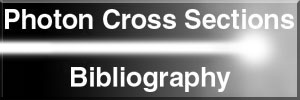1. Introduction
Since 1950 the National Institute of Standards and Technology (formerly
National Bureau of Standards) has maintained a data base of measured and
theoretical cross section data in the form of reprints, reports, and personal
communications. The purpose is to provide photon (XUV, x-ray, gamma-ray, and
bremsstrahlung) interaction data required in a variety of medical, industrial,
defense, and scientific applications. This data base has been used from time
to time for the tabulation of photon cross sections and attenuation
coefficients [1-11]. Here is presented a
bibliography of the published and unpublished research papers, comprising this
data base, reporting measured absolute photon interaction cross sections and
attenuation coefficients. This report updates an earlier bibliography by
Hubbell, Gerstenberg and Saloman in the report NBSIR 86-3461 (1986)
[12].
2. Compilation of the Bibliography
The items included in the bibliography have been acquired from
a variety of sources. The archival journals covered by Current Contents have
been reviewed both for articles on attenuation coefficients and for articles in
which attenuation coefficients have been measured incidentally to their main
objective. This report, as in reference [12]
draws on previous review articles and bibliographies
[13-24]. Also included are unpublished reports
and private communications. In cases where there is multiple publication of
essentially the same data only one reference is made. No attempt has been made
to eliminate anomalous data sets from this listing. The dates of the items in
the bibliography range from 1907 through 1995.
A summary of the number of items in this bibliography by decade of publication
is available with this table. There are a total of
580 separate references to a total of about 22,000 data points.
3. Description of the Bibliography
This bibliography, as well as the 1986 report [12],
is a further updated and enlarged version of the bibliography of reference
[25]. The six-character reference symbols are
again the same as those of reference [25]. The
first two characters are the last two digits of the year of publication (or
report). The next two characters are the first two letters of the first
author's last name. The final two digits (usually 01) are added to insure
uniqueness. The references are arranged in increasing order of year of
publication and within each year alphabetically by first author. For each item
the reference symbol is at the left margin. Next comes a listing of all authors,
the journal title, volume number, pagination and year (or alternate referencing
if not a journal article). The title of the article is given on the lines
following. On the last line, enclosed in parenthesis, is the photon energy
range studied and a listing of the elements measured in order of increasing
atomic number as well as a listing of any compounds measured. In addition to an
author index, an index to materials covered, arranged by atomic number for
elements, and alphabetically for compounds and for named substances, is
provided.
4. Discussion
This bibliography has been prepared as part of a critical evaluation of
photon absorption cross sections and includes references to all data sets
which provide either absolute cross sections or can be converted into absolute
cross sections. Not all the data represented by this bibliography are
consistent. As can be seen in the graphs of reference
[25], in a graphical intercomparison of Pb data by
Gerstenberg [26], and in soft x-ray intercomparisons
by Saloman et al. [27-29], some data sets
appear to have substantial systematic errors as compared with the "main
stream " of data points or with "reliable" theory.
Reference [29] provides both tabular and
graphical comparisons for energies between 10 eV and 100 keV between
the data covered in the 1986 bibliography [12],
the semi-empirical cross section compilation of Henke et al.
[14] and the theoretical photoionization values of
Scofield [30]. Further evaluations, compilations and
status reports on x-ray attenuation coefficients, also on the related
quantity, the energy-absorption coefficient, are given in references
[31-42].
The materials index at the end of this report will be useful to researchers
interested in making new x-ray attenuation measurements to fill gaps in the
existing experimental data which are the subject of this bibliography. The
four most-measured substances are carbon (106 references), aluminum
(179 references), copper (153 references) and lead (136 references).
The highest-density element osmium (Z=76) has yet to be measured, in
any photon energy region, perhaps because it is highly toxic as well as
otherwise difficult to handle.
5. Request for Additions and Corrections
Since it is desirable that the NIST data base continue to be as
up-to-date, accurate, and comprehensive as possible, the author will
appreciate receiving any corrections and additions to this work. He will also
appreciate receiving copies of any new papers containing photon attenuation
coefficient and cross section data.


